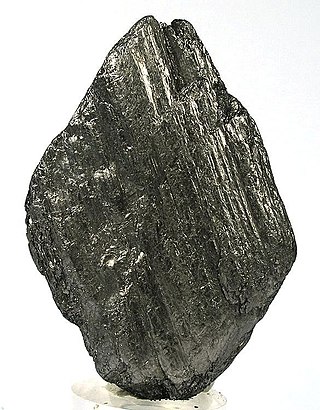
Graphite is a crystalline allotrope (form) of the element carbon. It consists of many stacked layers of graphene typically in the excess of hundred(s) of layers. Graphite occurs naturally and is the most stable form of carbon under standard conditions. Synthetic and natural graphite are consumed on a large scale for uses in many critical industries including refractories (50%), lithium-ion batteries (18%), foundries (10%), lubricants (5%), among others (17%). Under extremely high pressures and extremely high temperatures it converts to diamond. Graphite's low cost, thermal and chemical inertness and characteristic conductivity of heat and electricity finds numerous applications in high energy and high temperature processes.

Sintering or frittage is the process of compacting and forming a solid mass of material by pressure or heat without melting it to the point of liquefaction. Sintering happens as part of a manufacturing process used with metals, ceramics, plastics, and other materials. The nanoparticles in the sintered material diffuse across the boundaries of the particles, fusing the particles together and creating a solid piece.
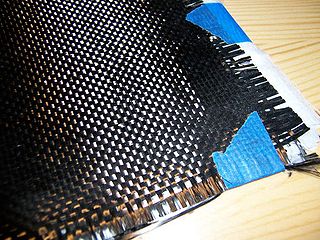
Carbon fibers or carbon fibres are fibers about 5 to 10 micrometers (0.00020–0.00039 in) in diameter and composed mostly of carbon atoms. Carbon fibers have several advantages: high stiffness, high tensile strength, high strength to weight ratio, high chemical resistance, high-temperature tolerance, and low thermal expansion. These properties have made carbon fiber very popular in aerospace, civil engineering, military, motorsports, and other competition sports. However, they are relatively expensive compared to similar fibers, such as glass fiber, basalt fibers, or plastic fibers.
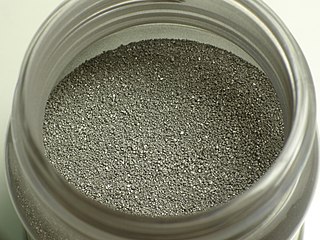
Powder metallurgy (PM) is a term covering a wide range of ways in which materials or components are made from metal powders. PM processes are sometimes used to reduce or eliminate the need for subtractive processes in manufacturing, lowering material losses and reducing the cost of the final product. This occurs especially often with small metal parts, like gears for small machines. Some porous products, allowing liquid or gas to permeate them, are produced in this way. They are also used when melting a material is impractical, due to it having a high melting point, or an alloy of two mutually insoluble materials, such as a mixture of copper and graphite.

Ultrasonic welding is an industrial process whereby high-frequency ultrasonic acoustic vibrations are locally applied to work pieces being held together under pressure to create a solid-state weld. It is commonly used for plastics and metals, and especially for joining dissimilar materials. In ultrasonic welding, there are no connective bolts, nails, soldering materials, or adhesives necessary to bind the materials together. When used to join metals, the temperature stays well below the melting point of the involved materials, preventing any unwanted properties which may arise from high temperature exposure of the metal.

Plastic welding is welding for semi-finished plastic materials, and is described in ISO 472 as a process of uniting softened surfaces of materials, generally with the aid of heat. Welding of thermoplastics is accomplished in three sequential stages, namely surface preparation, application of heat and pressure, and cooling. Numerous welding methods have been developed for the joining of semi-finished plastic materials. Based on the mechanism of heat generation at the welding interface, welding methods for thermoplastics can be classified as external and internal heating methods, as shown in Fig 1.
KUKA is a German manufacturer of industrial robots and factory automation systems. In 2016, the company was acquired by the Chinese appliance manufacturer Midea Group.

A brush or carbon brush is an electrical contact, often made from specially prepared carbon, which conducts current between stationary and rotating parts of an electrical machine. Typical applications include electric motors, alternators and electric generators. The lifespan of a carbon brush depends on how much the motor is used, and how much power is put through the motor.

Jenoptik AG is a Jena, Germany-based integrated photonics company. The company is listed on the Frankfurt Stock Exchange and is included in the TecDAX stock index.
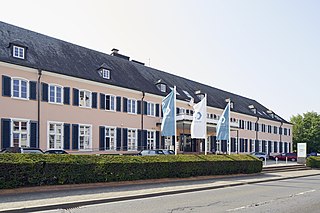
SGL Carbon SE is a European company based in Germany. It is one of the world's leading manufacturers of products from carbon.
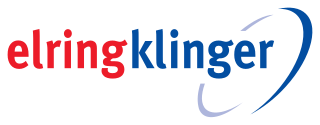
ElringKlinger AG is a German automotive supplier and car spare parts manufacturer headquartered in Dettingen an der Erms, Germany. As a worldwide development partner and original equipment supplier of cylinder-head and specialty gaskets, plastic housing modules, shielding components for engine, transmission, exhaust systems and underbody, exhaust gas purification technology as well as battery and fuel cell components ElringKlinger provides its products to almost all of the world's vehicle and engine manufacturers. As at May 3, 2017, in addition to the parent company, the ElringKlinger Group included 44 fully consolidated subsidiaries.
The CeramTec Group is a developer and manufacturer of products and components made of technical ceramics. The products are marketed through its own sales companies, among others. They are primarily used in medical technology, automotive engineering, electronics, equipment and mechanical engineering, environmental and energy technology, toolmaking, the chemical industry and the semiconductor industry. The company is headquartered in Plochingen in Baden-Württemberg, Germany.
An end effector is the device at the end of a robotic arm, designed to interact with the environment. The exact nature of this device depends on the application of the robot.
Kjellberg Finsterwalde is a group of German companies in the metal and electrical industry. The group consists of the three manufacturing companies, Kjellberg Finsterwalde Plasma und Maschinen GmbH, Kjellberg Finsterwalde Schweißtechnik und Verschleißschutzsysteme GmbH and Kjellberg Finsterwalde Elektroden und Zusatzwerkstoffe GmbH, and the Kjellberg Finsterwalde Dienstleistungsgesellschaft mbH, which fulfils group-wide functions. Sole shareholder of the group is the Kjellberg Foundation, with its registered seat in the Hessian city of Gießen. The group manufactures products for thermal metal working.

Ludwig Schunk was a German manufacturer and cofounder of the firm of Schunk und Ebe oHG.
The Ludwig-Schunk-Stiftung is a private foundation in the Central Hesse town of Heuchelheim, operated as a registered association. Its founding resulted from the last will and testament of the entrepreneur and company founder Ludwig Schunk (1884–1947). The Foundation holds one hundred percent of the registered capital of the Schunk Group.

Aerographite is a synthetic foam consisting of a porous interconnected network of tubular carbon. With a density of 180 g/m3 it is one of the lightest structural materials ever created. It was developed jointly by a team of researchers at the University of Kiel and the Technical University of Hamburg in Germany, and was first reported in a scientific journal in June 2012.

Diehl Metall is a corporate division of the Diehl Stiftung & Co. KG, a worldwide operating industrial group with its head office in Röthenbach an der Pegnitz near Nuremberg, Germany. The production units of Diehl Metall are situated at 13 locations in Europe, Asia, South America and the US. With 3,420 employees the company generated a turnover of €917 million in 2017. Diehl Metall produces semi-finished products, forgings and rolled products, high-precision stamped parts with plating technologies as well as Schempp+Decker press-fit zones and metal-plastic compound systems. The company provides material development and production, sheet metal forming and forging technology as well as plating, press-fit, overmolding and assembling technology completely in-house.
The HAHN Group GmbH is a conglomerate of companies that specialize in industrial automation and robotics. The headquarters are located in Rheinböllen, Germany.
















